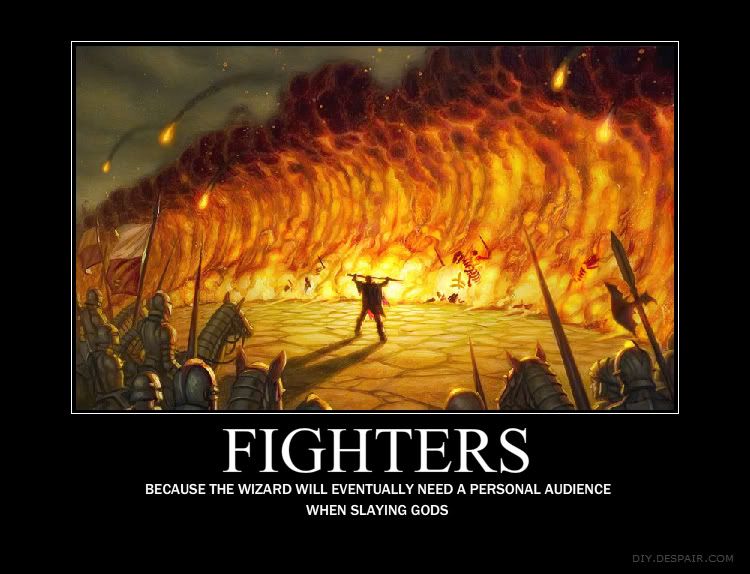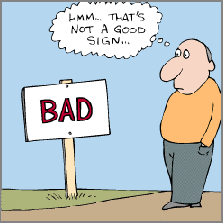Insomniac wrote:why are they still doing Race/Class? Show the classes first!
I don't write this shit, I just review it. But if I had to guess, I'd go with the overwhelming importance of "feeling like" D&D.
Now let's do classes.
Chapter 3: Classes
So way back when Mike Mearls was writing articles introducing 5e, the devs were making promises that every class in every PHB would be available to play in 5e. We have 12 classes here: Barbarian, Bard, Cleric, Druid, Fighter, Monk, Paladin, Ranger, Rogue, Sorcerer, Warlock, and Wizard. Now you might notice that "Assassin" and "Illusionist" aren't on the class list. Of more note is that there are 3 arcane casters - warlocks, sorcerers, and wizards. There's a table in the beginning of the chapter with a brief description of the classes:
"Sorcerer: A spellcaster who draws on inherent magic from a gift or bloodline"
"Warlock: A wielder of magic that is derived from a bargain with an extraplanar entity"
"Wizard:A scholarly magic-user capable of manipulating the structures of reality"
So what the fuck is the difference? Sure, the table tells me they get different save proficiencies, weapon proficiencies, and the nonwizards use Charisma while the wizards use Int. But I have no idea what kind of magic they use so this table tells me nothing. For fuck's sake, a sorcerer's "gift" could be the result of a bargain with some entity, and most pact-makers are seen browsing eldritch tomes. The damn bard even shows up in this table as a "An inspiring magician whose power echoes the music of creation" - which I guess kinda hints that he's a buffer, but as far as actual class descriptions I don't see a newbie figuring out what any of these mages do without reading the entire class entry. Fuck.
 Barbarian
Barbarian
d12 hit die, medium armor, 2 skills, etc. Rages now give advantage to all melee attacks, a damage bonus that scales by level, and resistance (take half damage) from all physical attacks. All the base features are centered around increasing strength, taking more punishment, and some unarmored fighting/dodging traps. Of note are the Indomitable Might feature allows you to take X on Strength checks, where X is your Strength score, and that at 20th level you can get up to 24 Strength and Con with a +4 bonus to each. Note that the normal number is 20.
Each of the classes here has a few Pathfinder style archetypes, as well. Barbarian has "Totem Warrior" and "Berserker". Berserker gives an extra attack each round while raging (3 attacks total at 5th level. Woo!), immunity to mind-affecting while raging, an intimidating presence based off Cha which is probably going to suck due to extreme MAD, and the ability to make a free attack on dudes who hit you first.
Totem Warrior actually can interact with the plot, they can talk to animals, commune with nature, and then get further abilities based on the totem spirit they pick. The 14th level benefits include an incredibly lame version of flight where you can't actually end your turn in the air or you fall, disadvantage to people who aren't you or who aren't bear warriors when they attack your team unless they go after you, or tripping people. At 14th level. Also your divinations aren't actually that great. For a character that's supposed to be participating in all three pillars, the barbarian only does combat well. They can kinda contribute to exploration with nature communes and nagging animals, but a berserker isn't gonna contribute shit that doesn't involve stabbing fools.
Bard
The bard in this edition is a level 9 full caster who can plunder spells off any spell list in the game. They also have a "bardic inspiration" class feature which lets people roll a d6 and add that to random d20 rolls, and is limited to daily usage until 5th level, when you can recharge all your uses after an hour of rest. They also get a hilarious capstone where you can get a use of this back "whenever you make an initiative roll", so you get one of your buddies to agree to start shit with you so you start a fight, roll initiative, and then decide not to fight after all. This continues until your DM gets pissed off and makes the longest friendship speech ever about how the rules aren't important because friendship.
There are two bard paths. One makes you into a crappier martial class with an extra attack and the ability to make one weapon attack when you cast a spell. The other lets you start plundering spell lists at 6th level instead of 10th, which you do so you can get animate dead and get on the minion train. Choo-choo!
 This was the first hit on Google Images for "hype train dnd". This tells us something. Something sad.
This was the first hit on Google Images for "hype train dnd". This tells us something. Something sad.
Cleric
Well, here we have the cleric class. This is a holy warrior, which is totally different than the paladin, which is a holy warrior. They are not the same thing. Fuck!
But unlike the wizard, warlock, and sorcerer, the paladin and the cleric have been separate classes from very early on in D&D. This particular iteration of the cleric is once again using the "all clerics share a spell list, but you also get a domain" version. Now, cleric is one of those classes that has become so bloated that it would be easy to split it into different classes, where you have a "light cleric" with a bunch of light based spells, a darkness cleric, an ice cleric for Thrym the Frostlord, Thor's thunder priests, etc - and there's enough to go around without having all the clerics having healing and anti-undead powers. Shit, if you're a cleric of a river god or something I don't know why you'd have specific powers over the dead. There are plenty of real-world divinities who
don't have dominion over the afterlife or the dead and could provide different powers than turning undead. But because this is a wacky mashup of Christian horror tropes and mythological gods...here we are.
The cleric gets two universal class features of note. The first is turning undead, which causes every undead in 30 feet to run away until they take damage or for 1 minute, whichever comes first. They can also destroy undead, but this is so weak you will forget you have it. A 17th level cleric can destroy CR 4 undead at max when turning. This will never work on anything you care about, and at 17th level you can just kill all the crap with an AoE spell.
The second class feature is to call for no-shit actual divine intervention. You use a standard action to describe what you want your god to do, then you roll a percentile die. If you're 20th level or you roll under your character level, then the DM determines how your god intervenes. Guidelines for this ability include "maybe you get a cleric spell or domain spell". Then if it works you can't use it for 7 days, but if it fails you need an 8-hour rest.
This is actually kinda shitty on every single level. First, it's pretty much a Mother May I ability which may as well not exist on the character sheet. From a "mechanical" perspective, most of the time it's just gonna be a waste of a standard action and if it works you have no clue what it's gonna do. (Note there is nothing stating your god can't get pissed and smite you). Second, this codifies that the gods will step in and personally intervene in
every single campaign setting. They go on to use Eberron deities as examples, but one of the things about Eberron religion is that the gods are distant and you don't actually get to see them or know if they're real. Hell, one of the major religions that grants clerical power over there is basically an undead self-improvement book. Sure, this is the kind of shit you could expect from FR, but actively intervening deities raises so much more questions than it answers ("Mommy, why doesn't Jesus smite the Lich King?") and requires an elaborate system of justification for why the world isn't a godsmote hellhole. Granted, only 10th+ level clerics can call down divine intervention, but they already get supernatural power from gods anyway so I don't see a reason for this class feature to exist.
On to domains. The domains in this book are Knowledge, Life, Light, Nature, Tempest, Trickery, and War. Of note is that this is 6 archetypal choices where the bard and barbarian got two, and that the Death priest is absent despite being a really popular player type. Each domain gives a stack of class features, such as a Channel Divinity usage (the cleric can use this ability or turn undead 1,2,or 3 times per rest), a bonus proficiency or cantrip or something, and a few other abilities. You also get to auto-prepare domain spells, and you get two each spell level from 1-5.
Knowledge: Get skill bonuses, learn extra languages,arbitrarily get proficiency in any skill or tool of your choice as channel divinity OR read people's minds and hit them with suggestions. You also get +Wisdom to damage with cleric cantrips, and the ability to randomly perform object reading at 17th level. Now this has traditionally been a psionic ability in D&D, but fuck it. Domain spells are divinations, command, and confusion.
Life: You are a big sucker, because all your domain spells are on the cleric list already. You also get extra weapon damage and heavy armor proficiency, but you don't care because if you were doing that you'd be a war cleric which gets that and martial weapon proficiencies. Your other class features involve buffing your healing skills so you heal more damage with each cast. Sure, you can maximize your healing at 17th level, but I'm not even gonna pretend the "heal someone else and it also heals me for 2+spell level" is a class feature you will ever care about. The channel divinity heals 5 * cleric level 1/encounter, which isn't terrible but won't fully keep up with damage - EXCEPT THAT YOU CAN ONLY HEAL UP TO HALF MAX HP. For example, the CR 17 red dragon from the basic rules can put out at most 107 damage in a round if the multiattack hits and all three of the tail sweeps connect. This feature heals 85 points of damage, 3 per encounter at this level. If you bust out your mass heal it will heal 700 hit points divided among the team... with an additional bonus of 11 hp healed per target. If you cast cure wounds at 9th level, that heals 83 + Wis - which can't go above 5, so 86 - hit points per level. You get one 9th level spell per day. This dragon can keep making 6 attacks per combat round. This thing has a +14 to hit against an AC of 20 in plate and shield before buffs or magic items(of which you get like 3 ever and you are in no way guaranteed to get armor). Now each attack does 15-21 damage or so if we use the averages instead of rolling, so given the 1/4 chance our dragon has of missing means that the Channel Divinity can kinda keep up with the dragon full attacks if someone gets 170 hp. But that half HP max is the real killer here, so my advice is to not be a life cleric.
Light: 4e laser clerics and Fire Emblem bishops make their triumphant return! You get a bunch of fire spells which are wastes of time, because by the time you get, say, fireball (8d6 damage, or 28 damage on average) you're running into CR 5 monsters who have 90 hit points (Air Elemental). So much for fixing Padded Sumo. You get the light cantrip for free because torches are expensive or something. You get to laser people to impose disadvantage on enemy attack rolls as a reaction Wis modifer times per day, your channel divinity is a laser that shoots everything in 30 feet for 2d10+cleric level damage and dispels darkness (this will never be level appropriate), get +Wis to cantrip damage because coming up with new class features is hard, and can impose disadvantage on saves against fire and radiant damage spells you don't want to cast because they suck. Don't be a light cleric.
Nature[/b]: You have a ton of conceptual space to cover, such as Water, Death, Darkness, Cold, Earth...and you give us a nature cleric despite the fact that we have a whole nature-aligned priest class on the next page. You could probably put in a whole class or two if you pruned the redundant character concepts out of this book.
That said, you get to plunder the druid list for animal related spells, heavy armor proficiency (what the fuck? Druids traditionally couldn't wear plate, but it's a nature priest specialty? What the shit, game?), extra weapon damage but with an energy type (wow, we can't think of class features, now can we?), a reaction that halves energy damage against your allies for one type of energy damage for one turn, and charming animals. Uninspired and feels mostly recycled, but hey at 17th level you can actually order the animals you charm, until they trip over a rock and take one point of damage and the effect is gone forever. 5e!
Tempest: bonus proficiencies with martial weapons, heavy armor. I feel like I've seen this before...
You also get to auto-maximize any lightning or thunder damage you deal with channel divinity (and your domain gives you some lightning spells, even though I don't see anything that can get above 30 damage unless you start heightening thunderwave), zap melee attackers for 2d8 damage wis mod/day and push people 10 feet on dealing lightning damage. And, of course, no domain would be complete without bonus weapon damage! The final ability is so far the only thing I've found that's a cool high-level ability - infinite flight at your walking speed when you're not underground or indoors. Naturally, if you take this, all your adventures will be underground or indoors.
Trickery: add some charms, illusions, dimension door, and some decent save-or-dies to your spell list. Randomly give allies (but not yourself!) advantage on stealth checks for an hour, which is pretty much a non-ability because there are no rules for stealth. You get two channel divinities, one to make an illusion of yourself to cast spells through and one to turn invisible...for a round. That breaks if you attack or cast a spell. Yeah....
You also get the bonus weapon damage, but it's poison damage this time! (Yawn) and your ultimate ability is to create 4 illusions instead of one which is actually pretty cool.
War: Everything is on the cleric list with the exceptions of stoneskin, hold monster, and magic weapon. You get a bizarro bonus attack but not really where you can only make an extra attack Wis mod times per day, channel divinity to get +10 to one attack roll which is actually really good in bounded accuracy land, bonus weapon damage, and resistance to physical damage from nonmagic weapons, which is basically free stoneskin and worse than what the barbarian got at level 1.
That took way longer to write up than I thought it would, so we continue our class related slog tomorrow!









